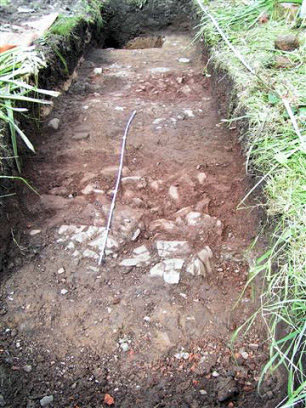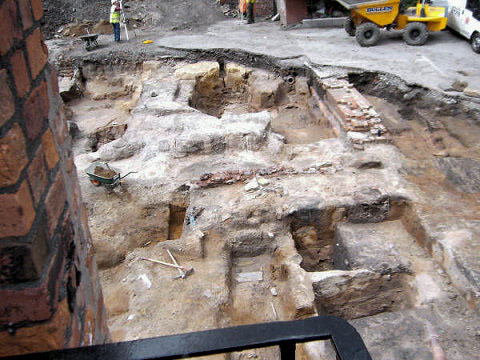
Last month Brian Parr noticed that remediation work was continuing in Higher Ince in the area we have been looking for the Roman road (see Newsletter 101). He quickly got permission to dig in the back garden of No.24 Heber Street (just off Bird Street). With the remediation work temporarily suspended a trench was opened up and a section of ‘road’ was uncovered at depth of about 30cm. At the time of writing this looks quite promising as it appears to be the right width (9.5m), has a slight camber with a substantial ditch on the north side and a smaller one on the south. It is mainly made of clay but some of the metalling survives in the form of compacted stone over a 1.5m area in the middle. A word of caution however - on the 1849 6” OS map a track and field boundary is marked at this point and it is highly likely that this is what has been found here. It does not, however, preclude a Roman origin but proving it is going to be very difficult. Brian and his small team are rapidly trying to record as much as they can before remediation work commences on Monday.
Amberswood GPS
Also last month Joe Taylor from Billinge Historical Society came down with his GPS equipment to see if he could pinpoint the line of the Roman Road as it runs across Amberswood Common. Just south of the railway is the densely wooded area of Moss Hall which, in the past, has proved particularly difficult for us to get accurate measurements using known datum points. However using a scaled version of the 1849 6" OS map overlaid on Google Earth, we were able to give Joe a series of co-ordinates which he could then take us to on the ground. In this way, 4 locations for the line were established - including points on Seaman Way, the land-fill site fence, the old waste disposal track on the Ince-Hindley border and the old Lancashire Union railway embankment. We also took the opportunity to drop a couple of small test pits where the line crossed the land-fill fence to see if we could spot anything. If you want to see the results from this activity visit our forum web page here (log in first).
Rectory Survey
In July, before the schools finished, Tom (our chairman) organised a second resistivity survey of the Rectory lawn with the help of the pupils from the Deanery High School. This was a useful exercise in that we were able to confirm our previous readings and also give the children a great insight in the type of archaeological work we are involved with. This project will continue once the children return to school.
Grant Awarded
Tom has also secured another grant for the society – this time from the Community Chest. The money will go towards upgrading and enhancing our resistivity meter equipment. With the money, we have also been able to buy 2 steel lockable cabinets to store the equipment at the Scout HQ. The scouts have kindly given us the use of a back room specifically for this purpose. They have also issued us with a spare key to allow extra access during weekdays when Tom is not available. To give the scouts more confidence, Tom has suggested we give our designated key-holder the office of vice-chairman. This office does not exist at this time, and the next opportunity to create it would be an EGM in November. However, until then, Brian Parr has volunteered to act in this capacity.
Moore’s Yard
Work is coming to a close on this site which lies just south of the Wiend in the heart of Wigan. The expected evidence of Roman occupation did not materialise, however the archaeologists did discover more rare evidence of Medieval Wigan. Significantly though, for the first time, volunteers were welcomed on the excavation site and I would like to thank Clare Gardener of Oxford Archaeology North for her patience with the 3 Society members who took part.

Next Meeting
Wednesday 3rd September at the District Scout HQ (Baden Powell Centre) in Greenough Street, starting at 7.30 pm as usual. Ben Edwards will be our speaker with a talk on Roman Cavalry Tombstones. This will include the story of the recently discovered Lancaster Tombstone (see Newsletter 90). Ben helped in the translation of this remarkable monument which was dedicated to a cavalryman from Trier in
Germany. It sounds like a most enlightening talk.
Hope to see you there B.A.
|



